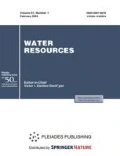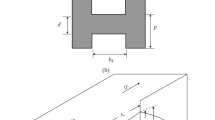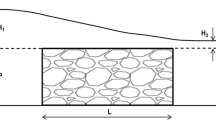Abstract
Combined weir-gate structure is one of the important structures which are control the water level, measure discharge and avoid sediment deposition behind the weir. In this study, first try to simulate four combined triangular weir-rectangular gates with different geometric conditions via 3D numerical software (Flow-3D) by using experimental data. Then, dimensionless analyses were done to find the non-dimension parameters affected the discharge coefficient of this structure. At the end, four different intelligent system models were used to estimate the discharge coefficient, evaluated and compared the results with each other. Results show that the Flow-3D software has a high capability to simulate the flow over the combined structure. Besides, the values of goodness of fit criteria show that the numerical solver, estimate the water head and discharge coefficient very well. Moreover, in all models, the results show that the discharge coefficient has an inverse relation with dimensionless parameters (h/b, h/d and h/y) and discharge coefficients in this study are between 0.3–0.9. On the other hand, results of accuracy analyses of four intelligent system models of MLP, RBF, GRNN and M5P show that the MLP model is the superior model in this study, and after that, the rest of models’ sort as M5P, RBF and GRNN in this study.












Similar content being viewed by others
REFERENCES
Abidin, K., Artificial neural network study of observed pattern of scour depth around bridge piers, Comput. Geotech., 2010, vol. 37, no. 3, pp. 413–418. https://doi.org/10.1016/j.compgeo.2009.10.003
Ahmed, F.H., Characteristics of discharge of the combined flow through sluice gates and over weirs, J. Eng. Techn., Iraq, 1985, vol. 3, no. 2, pp. 49–63. (in Arabic)
Alhamid, A.A., Husain, D., and Negm, A.M., Discharge equation for combined flow over rectangular weirs and below inverted triangular weirs, Arab Gulf J. Sci. Res., 1996, vol. 14, no. 3, pp. 595–607.
Alhamid, A.A., Negm, A.M., and Al-Brahim, A.M., Discharge equation for proposed self-cleaning device, J. King Saud Univ., 1997, vol. 91, pp. 13–24.
Amini, N., Balouchi, B., and Shafai Bejestan, M., Reduction of local scour at river confluences using collar, J. Sediment. Res., 2017, vol. 32, no. 3, pp. 364–372.
Balouchi, B., Abedini, M.J., and Manhart, M., A simulation-optimization technique to estimate discharge in open channels based on water level data alone–Gradually Varied Flow condition, IJSTC Journal, Springer, 2018, vol. 43, no. 8, pp. 1–15. https://doi.org/10.1007/s40996-018-0149-5
Balouchi, B. and Abedini, M.J., System identification and subsequent discharge hydrograph estimation in waterway corridors based on water level data alone—Unsteady flow condition, J. Hydrol. Engin., ASCE, 2019, vol. 24, no. 10. https://doi.org/10.1061/(ASCE)HE.1943-5584.0001848
Balouchi, B., Nikoo, M.R., and Adamowski, J., Development of expert systems for the prediction of scour depth under live-bed conditions at river confluences: Application of different types of ANNs and the M5P model tree, Appl. Soft Comp. J., 2015, vol. 34, pp. 51–59.
Balouchi, B. and Rakhshanderoo, G.R., Using physical and soft computing models to evaluate discharge coefficient for combined weir gate structures under free flow condition, IJST Journal, 2018, vol. 42, no. 1. https://doi.org/10.1007/s40996-018-0117-0
Balouchi, B. and Shafai Bajestan, M., The effect of bed load on maximum scour depth at river confluence, Ecol.,Environ. Conserv., 2011, vol. 18, no. 1, pp. 157–164.
Bateni, S.M., Borghei, S.M., and Jeng, D.S., Neural network and neuro-fuzzy assessments for scour depth around bridge piers, J. Eng. Appl. Artif. Intel., 2007, vol. 20, no. 3, pp. 401–414. https://doi.org/10.1016/j.engappai.2006.06.012
Bilhan, O., Emiroglu, M.E., and Kisi, O., Use of artificial neural networks for prediction of discharge coefficient of triangular labyrinth side weir in curved channels, Adv. Engin. Soft., 2011, vol. 42, pp. 208–214.
Cheng, M.Y., Cao, M.T., and Wu, Y.W., Predicting equilibrium scour depth at bridge piers using evolutionary radial basis function neural network, J. Comput. Civil Eng., 2014, vol. 29, no. 5, 04014070. https://doi.org/10.1061/(ASCE)CP.1943-5487.0000380
Cigizoglu, H.K., Artificial neural networks in water resources, Integr. Inf. Environ. Security, 2008, pp. 115–148. https://doi.org/10.1007/978-1-4020-6575-0_8
Dehghani, A.A., Bashiri, H., Meshkati, E., Ahadpoor, A., Experimental investigation of scouring in downstream of combined flow over weirs and below gates, 33rd IAHR Conf., Canada, 2009, pp. 3604–3609.
El-Saiad, A.A., Negm, A.M., and Waheed El-Din, U., Simultaneous flow over weirs and below gates, Civil Eng. Res. Mag., 1995, vol. 17, no. 7, pp. 62–71.
Emiroghlu, M.E., Bilhan, O., and Kisi, O., Neural networks for estimation of discharge capacity of triangular labyrinth side-weir located on a straight channel, Expert Syst. Applic., 2011, vol. 38, pp. 867–874.
Ferro, V., Simultaneous flow over and under gate, J. Irrig. Drain. Eng., 2000, vol. 126, no. 3, pp. 190–193.
Flow-3D, User manual, Flow Science Inc., 2008.
Juma, I.A., Hussein, H.H., and Al-Sarraj, M.F., Analysis of hydraulic characteristics for hollow semi-circular weirs using artificial neural networks, Flow Meas. Instrum., 2014, vol. 38, pp. 49–53.
Lee, T.L., Jeng, D.S., Zhang, G.H., and Hong, J.H., Neural network modeling for estimation of scour depth around bridge piers, J. Hydro Dyn., 2007, vol. B19, no. 3, pp. 378–386. https://doi.org/10.1016/S1001-6058(07)60073-0
Li, C.F., Zhang, J.B., and Wang, S.T., Comparative study on input-expansion-based improved general regression neural network and Levenberg-Marquardt BP network, Lecture Notes in Computer Sci., 2006, vol. 4113, pp. 83–93.
López-Martín, C., Predictive accuracy comparison between neural networks and statistical regression for development effort of software projects, Appl. Soft Comput., 2015, vol. 27, pp. 434–449. https://doi.org/10.1016/j.asoc.2014.10.033
Mohamed, H.I., Abozeid, G., and Shehata, S.M., Hydraulics of clear and submerged overfall weirs with bottom circular openings, Ain Shams Eng. J., 2011, vol. 1, no. 2, pp. 115−119. https://doi.org/10.1016/j.asej.2011.03.004
Negm, A.M., Characteristics of combined flow over weirs and under gate with unequal contractions, Proc. 2nd Int. Conf. on Hydro-Sci. Engineering, Beijing, China, 1995, vol. 2, no. A, pp. 285–292.
Negm, A.M., Al-barahim, A.M., and Al-hamid, A.A., Combined free flow over weirs and gate, J. Hydraulic Res., 2002, vol. 40, no. 3, pp. 359–365.
Negm, A.M., El-Saiad, A.A., Alhamid, A.A., and Husain, D., Characteristics of simultaneous flow over weir and below inverted V-Notches, Civil Engin.Res. Magazine(CERM), 1994, vol. 16, no. 9, pp. 786–799.
Negm, A.M., El-Saiad, A.A., and Saleh, O.K., Characteristics of combined flow over weirs and below submerged gates, Proc. of Al-Mansoura engineering 2nd Int. Conf. MEIC’97, 1−3 April, Faculty of Engineering, Al-Mansoura Univ., Al-Mansoura, Egypt, 1997, vol. III, no. B, pp. 259–272.
Pal, M. and Deswal, S., M5 model tree based modeling of reference evapotranspiration, Hydrol. Processes, 2009, vol. 23, pp. 1437–1443.
Quinlan, J.R., Introduction of decision trees, Machine learning, 1986, vol. 1, pp. 81–106.
Quinlan, J.R., Learning with continuous classes, Proceedings of the Fifth Australian Joint Conf. Artificial Intelligence, Hobart, Australia, World Scientific, Singapore, 1992, pp. 343–348.
Specht, D.F., A General Regression Neural Network, IEEE Trans. Neural Netw., 1991, vol., 2, no. 6, pp. 568–576.
Author information
Authors and Affiliations
Corresponding authors
Rights and permissions
About this article
Cite this article
Nima Aein, Najarchi, M., Hezaveh, S.M. et al. Application of 3D Numerical Model and Intelligent Systems in Discharge Coefficient Estimation of Combined Weir-Gate. Water Resour 47, 537–549 (2020). https://doi.org/10.1134/S0097807820040028
Received:
Revised:
Accepted:
Published:
Issue Date:
DOI: https://doi.org/10.1134/S0097807820040028




